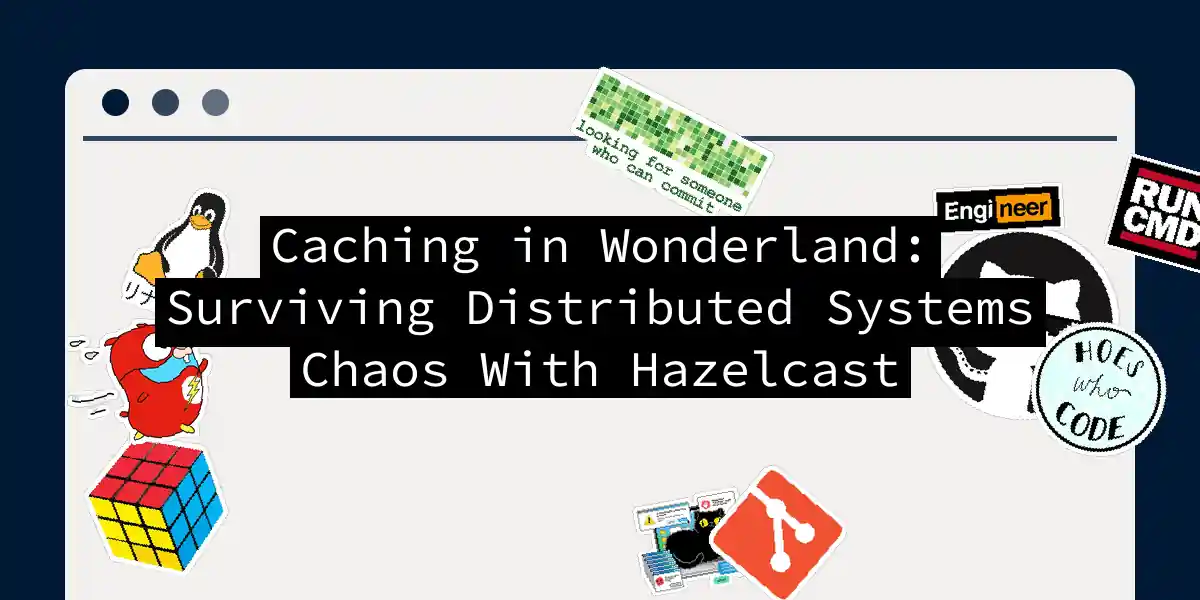Picture this: you’re Alice falling down the rabbit hole of distributed systems, and Hazelcast is your Cheshire Cat - always grinning with solutions. Let’s build a distributed caching system that even the Queen of Hearts would approve (just don’t mention cache invalidation at tea time).
Preparing the Mad Hatter’s Toolkit
First, let’s brew our dependency potion in the pom.xml cauldron:
<dependency>
<groupId>com.hazelcast</groupId>
<artifactId>hazelcast-all</artifactId>
<version>5.5.0</version>
</dependency>
<dependency>
<groupId>org.springframework.boot</groupId>
<artifactId>spring-boot-starter-cache</artifactId>
</dependency>
Now let’s configure our looking glass (hazelcast.yaml):
hazelcast:
cluster-name: Wonderland
network:
join:
multicast:
enabled: true
rest-api:
enabled: true
endpoint-groups:
HEALTH_CHECK:
enabled: true
This configuration lets our nodes find each other like playing cards gossiping in the royal garden.
The Rabbit Hole of Cache Configuration
Let’s create our own version of the White Rabbit’s pocket watch - a cache manager that’s always on time:
@Configuration
@EnableCaching
public class CacheConfig {
@Bean
public Config hazelcastConfig() {
Config config = new Config();
config.addMapConfig(new MapConfig("magicMushroomCache")
.setTimeToLiveSeconds(300)
.setMaxSizeConfig(new MaxSizeConfig(1000, MaxSizeConfig.MaxSizePolicy.PER_NODE)));
return config;
}
@Bean
public HazelcastInstance hazelcastInstance() {
return Hazelcast.newHazelcastInstance(hazelcastConfig());
}
}
This creates a cache where entries vanish like the Cheshire Cat after 5 minutes (300 seconds).
Through the Looking Glass: Cluster Formation
Let’s visualize our distributed wonderland:
Our nodes whisper cache updates to each other like royal gardeners sharing secrets. To test this madness:
# Start three terminal tabs
mvn spring-boot:run -Dserver.port=8081
mvn spring-boot:run -Dserver.port=8082
mvn spring-boot:run -Dserver.port=8083
Watch the logs as nodes discover each other - it’s like the Mad Hatter’s tea party, but with TCP connections!
The Red Queen’s Cache Race
Let’s implement a service that would make the Red Queen proud of its speed:
@Service
public class TeaPartyService {
@Cacheable("magicMushroomCache")
public Mushroom findMushroom(String type) {
// Simulate slow database query
try { Thread.sleep(2000); }
catch (InterruptedException e) {}
return new Mushroom(type, "Eat me!");
}
}
First call takes 2 seconds (gardening time), subsequent calls are instant - like magic! Add this annotation to your controller methods for maximum speed.
Tweedledee and Tweedledum’s Troubleshooting Guide
When things go Wonderland-wrong:
- Nodes not connecting? Check multicast settings - your network might be more guarded than the Queen’s tarts
- Cache entries disappearing? Your TTL (Time To Live) might be shorter than the White Rabbit’s attention span
- Cluster split? Implement a backup count higher than the number of flamingo croquet mallets
// For important data, add backups
new MapConfig()
.setBackupCount(2)
.setAsyncBackupCount(1);
The Never-Ending Tea Party
Remember: in distributed systems, the only certainty is uncertainty. Hazelcast helps keep your cache as consistent as the Dormouse’s napping schedule. For your next adventure:
@CacheEvict(value = "magicMushroomCache", allEntries = true)
public void clearCache() {
// Mad Hatter's clean slate
}
Now go forth and cache like you’ve got a personal arm of the Jabberwocky handling your invalidation! Just watch out for those OutOfMemory hedgehogs…
